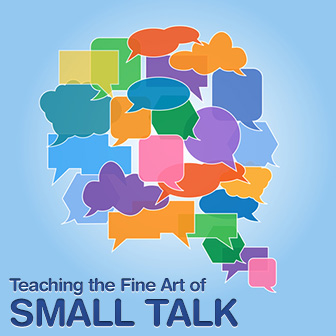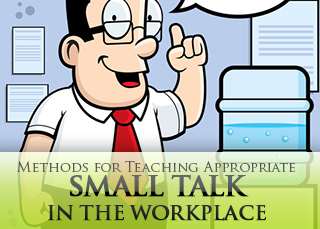So How about those Giants? Teaching the Fine Art of Small Talk


The place to do this in an office may not be a literal water cooler, of course, but a break room or the back parking lot or front lawn, any place employees gather to relax. But wherever it actually takes place, there are specific topics and rules for office “water cooler talk.” There are, for example, specific topics and specific ways to enter, maintain, and exit a conversation.

Interestingly, the main topic not to discuss during water cooler talk at the office is work itself. There are a few reasons for this: during “water cooler” talk, employees are taking a break from work, and a colleague who brings it up might be considered annoying. In addition, there is the real concern of being caught by the boss discussing a sensitive subject, like how irritating a specific client is. So this brief respite from work and talk about work should be taken as such. The following are some good topics for water cooler talk.
Asking after each other’s family is usually a safe and neutral topic of conversation, as in the general “Hey, Dan, how’s the family?” to the more specific “Susan, how did your daughter’s dance recital go?” for coworkers who are more informed about each other’s lives. Too personal of comments, such as the marital difficulties a coworker may have confided in private, are of course not welcome at “water cooler talk,” as this is actually a public, not private, forum.
Sports are also a safe topic, for the most part, such as “How about those Giants!” an expression of admiration for the Giants’ success. Even sports, however, can become at times to “partisan” and negative, as when a coworker sharply criticizes a local team. Because this can quickly become uncomfortable, it’s best to stay more positive and general on comments about sports.
Sharing information about vacations, vacation places, and activities is also a popular water cooler topic, especially around the time of year when people typically go on vacation, such as the school holidays, when people’s children are off from school. “So what are your plans for vacation this year?” is an acceptable conversational opener, and might give the speaker some ideas for vacation—while causing no particular embarrassment for the addressee if he must respond his plan is to stay home, as he can then talk about planned activities at home.
Keeping up on coworkers’ specific hobbies and interests outside of the office shows concern for them as individuals and because recreation is removed from the workplace is particularly suited for water cooler talk. Most coworkers will appreciate the sensitivity of the coworker who asks about a hobby: “So how’s the novel coming, Mary?” or “Are you able to play much golf this days, Dave?” These conversational openers go beyond remembering a coworker’s name in recognizing individuality and open the door to further conversation, as most people are excited about discussing hobbies.
Finally, popular entertainment such as movies and TV, as part of the shared culture unrelated to work, are also suitable discussion topics. “So did you see the new Bond movie?” is a conversational opener than can lead to an interesting discussion of the new movie and James Bond movies in general, as well as lead to a decision of some conversation participants on whether or not they want to see the movie.

Many students, depending on their cultures, may be unfamiliar with the idea of a short period of time (sanctioned by the company), in which employees openly gather to relax and talk. A clip from an American TV show such as “The Office,” in which characters engage in the rituals of workplace behavior, might help.
“Hey, Bob, how’s it going?” is a good opener. (I’m not sure when exactly in the U.S. “hey” replaced “hi,” but that is a part of the discourse now students should be aware of.) Other good ways to begin a conversation are “So how’s the family/your new car/your neighbor Tracy?” An innocuous inquiry into the well-being of the people and things in the listener’s life is always welcome. Finally, a question into the listener’s insights is also almost always appreciated: “What did you think about the new James Bond film?” and “Do you think the Giants are doing well this season, or do they need to work harder?” are all ways to begin a conversation. Graceful ways to close are “Great talking to you, but I’ve got to get back to work,” and “Oops, looks like time is up. Talk to you later.”
Using the language students have already been introduced to, create short dialogues and exchanges for them of language actually used at the water cooler. Put the students in groups of two or three and give them the option of performing from their desks or before the classroom.
Once students have been introduced to and practiced a scripted, structured “water cooler” conversation, they are ready venture on their own, conducting a conversation much as in the actual workplace. Put students around something that might stand in for the water cooler—perhaps a water bottle on a desk—and have several students gather around it. You may assign them roles—the receptionist, the accountant, the office manager—and a topic and have them act out the conversation. More advanced students can choose their own roles/topics.
However, because this kind of conversation is integral for building relations with coworkers, of knowing their names and interests, it is actually critical to success in the workplace.
What are some topics you would teach for “water cooler” talk? How would you teach it?